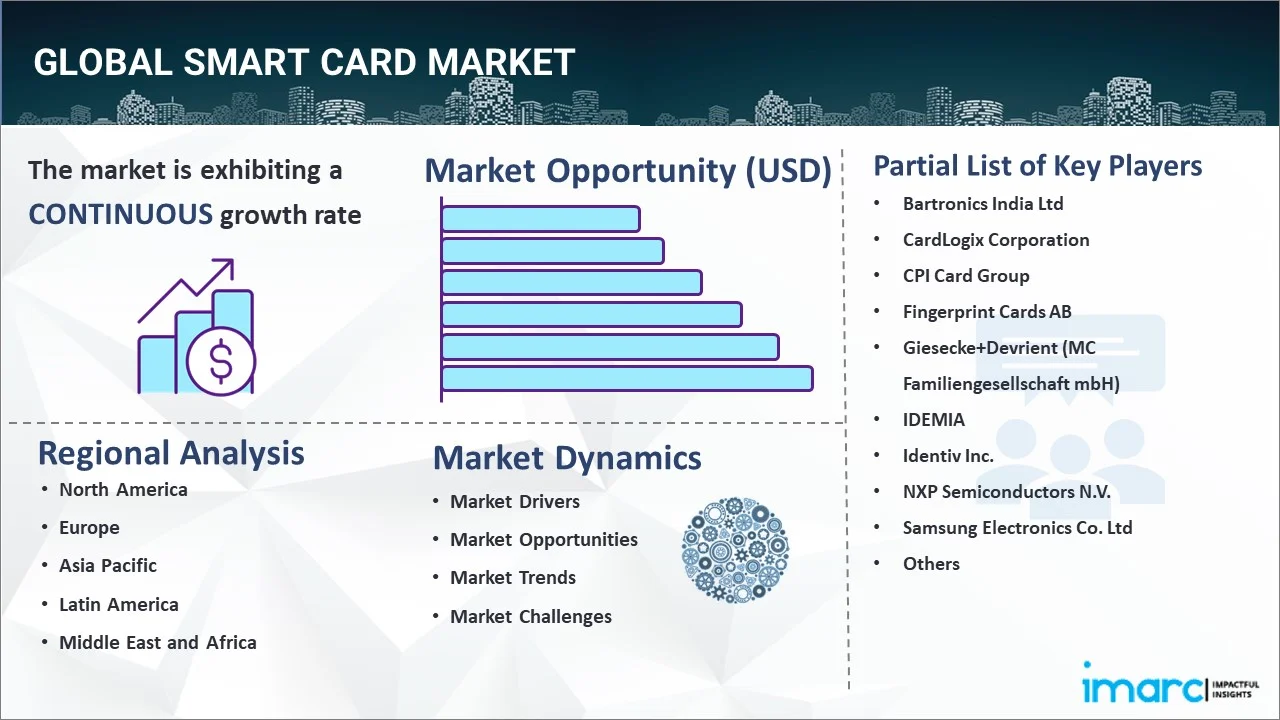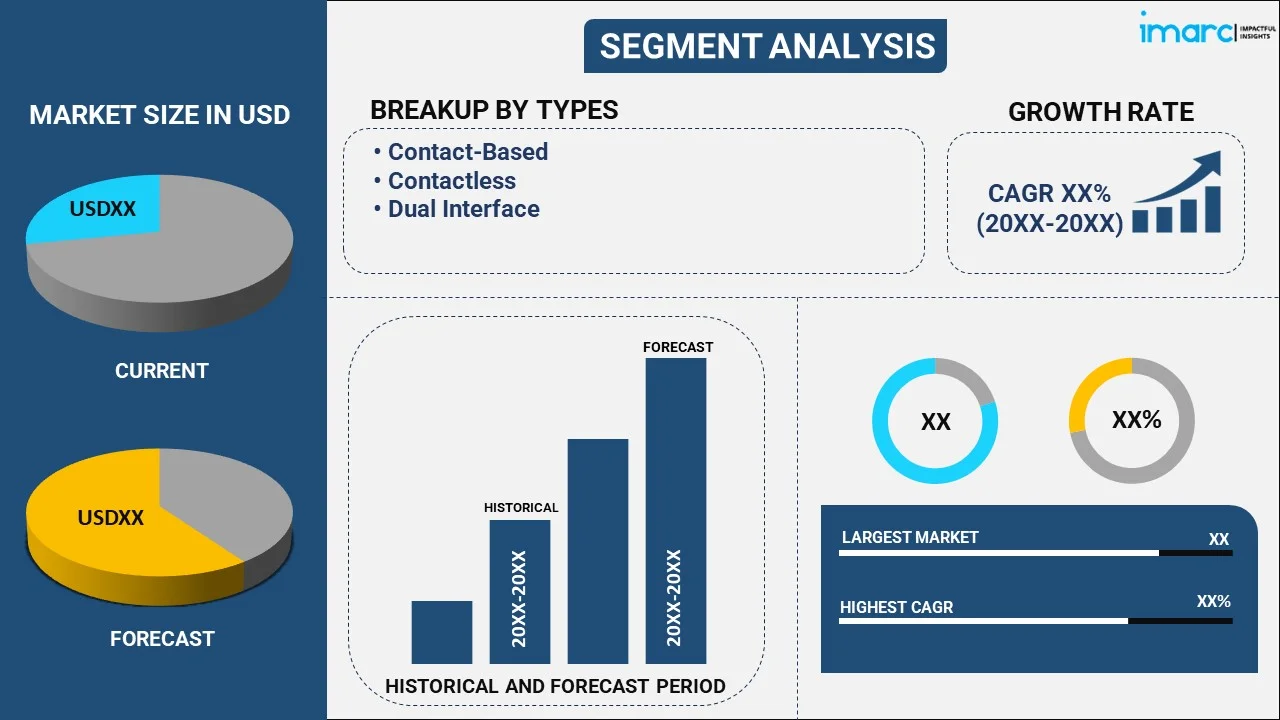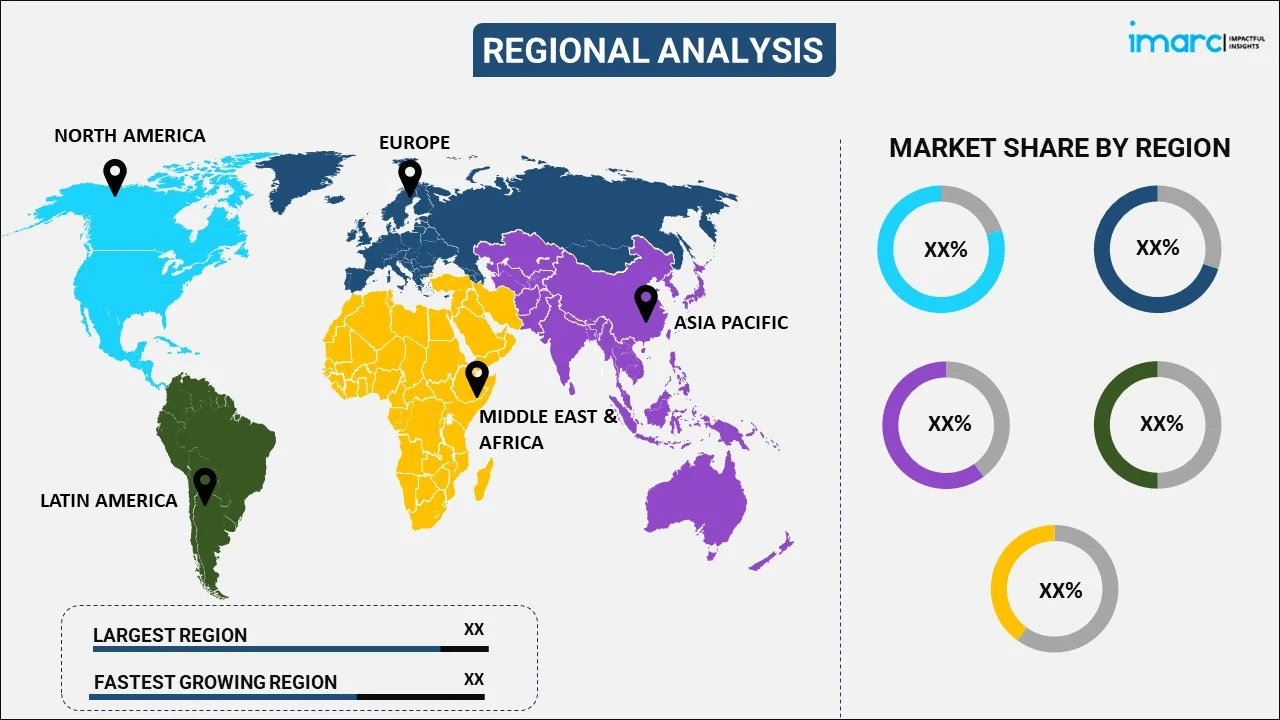
Smart Card Market Report by Type (Contact-Based, Contactless, Dual Interface), Component (Memory Based, Microcontroller Based, Magnetic Stripes), Application (Payment Transactions, ID Verification, Access Control), End User (BFSI, Telecommunication, Healthcare, Government, Transportation, and Others), and Region 2025-2033
Market Overview:
The global smart card market size reached USD 10.2 Billion in 2024. Looking forward, IMARC Group expects the market to reach USD 14.0 Billion by 2033, exhibiting a growth rate (CAGR) of 3.6% during 2025-2033. The integration of smart card technology into mobile devices, smartphones, and wearables, growing need for secure and efficient payment systems, and the increasing utilization of smart cards by public corporations and organizations are some of the major factors propelling the market. At present, Asia Pacific holds the largest market share, driven by growing population, paired with rapid urbanization and economic development.
|
Report Attribute
|
Key Statistics
|
|---|---|
|
Base Year
|
2024 |
|
Forecast Years
|
2025-2033
|
|
Historical Years
|
2019-2024
|
| Market Size in 2024 | USD 10.2 Billion |
| Market Forecast in 2033 | USD 14.0 Billion |
| Market Growth Rate 2025-2033 | 3.6% |
Smart cards, also known as chip cards or integrated circuit cards (IC cards), are small, portable plastic cards with embedded integrated circuits. These integrated circuits contain microprocessors and memory chips, which enable the card to store and process data securely. They are used for government-issued ID cards, employee badges, and membership cards. They can also store patients' medical records and insurance information, improving the efficiency of healthcare services. Smart cards are used for various applications and are known for their versatility and security features.

The global smart card market value is experiencing robust growth driven by increased adoption across diverse sectors, including banking, healthcare, telecommunications, and transportation. Additionally, governments worldwide are actively promoting the use of smart cards for citizen identification, e-passports, and e-government services, further propelling market expansion. Furthermore, the widespread adoption of smart cards has been accelerated by the global COVID-19 pandemic, as there is a heightened demand for contactless payment methods. Additionally, the integration of smart card technology into mobile devices, smartphones, and wearable gadgets, along with the increasing popularity of contactless payment systems, is driving market growth. Moreover, the surge in online transactions, the rapid growth of the e-commerce industry, and the increasing adoption of digital banking are contributing to a positive market outlook. Additionally, public corporations and organizations are increasingly using smart cards for employee identification (ID) cards to enhance security for access to physical facilities and computer systems and networks.
Smart Card Market Trends/Drivers:
Integration of smart card technology into mobile devices, smartphones, and wearables
The integration of smart card technology into smartphones has driven the adoption of contactless payment methods, such as NFC (Near Field Communication) payments. Consumers can simply tap their smartphones to make payments, eliminating the need for physical credit or debit cards. This convenience has accelerated the transition to mobile payments and boosted the demand for smart card solutions. Moreover, smart card technology in mobile devices enables the implementation of multiple applications on a single card. For example, a single smart card in a smartphone can support payment, public transportation, access control, and more. This versatility enhances user convenience and encourages broader adoption of smart card technology.
Growing need for secure and efficient payment systems
Smart cards provide a higher level of security compared to traditional magnetic stripe cards. They use encryption and authentication mechanisms to protect sensitive data, making them more resistant to fraud and data breaches. As the frequency of cyberattacks and payment fraud increases, the demand for secure payment solutions like smart cards grows. Moreover, contactless smart cards, often in the form of EMV (Europay, MasterCard, and Visa) cards, enable quick and convenient tap-and-go payments. The COVID-19 pandemic accelerated the adoption of contactless payments as consumers sought safer, touch-free payment methods. Smart cards play a pivotal role in enabling this technology, which is propelling the market growth.
Increasing utilization of smart cards by public corporations and organizations
Many governments worldwide are promoting the use of smart cards for identification, access control, and secure transactions. This includes national ID cards, e-passports, and driver's licenses with embedded chips. These initiatives are driving a significant demand for smart cards. Besides, public corporations and organizations are adopting smart cards for secure access control to their premises and digital resources. Smart cards provide multi-factor authentication, making it difficult for unauthorized individuals to gain access to sensitive areas or information. Moreover, public transportation systems, government offices, and public services are increasingly adopting smart card-based payment systems. This includes contactless smart cards for fare payments in buses and trains, reducing the need for cash transactions.
Smart Card Industry Segmentation:
IMARC Group provides an analysis of the key trends in each segment of the global smart card market report, along with forecasts at the global, regional, and country levels for 2025-2033. Our report has categorized the market based on type, component, application, and end user.
Breakup by Type:

- Contact-Based
- Contactless
- Dual Interface
Contact-based cards hold the largest market share
The report has provided a detailed breakup and analysis of the market based on the type. This includes contact-based, contactless, and dual interface. According to the report, contact-based cards accounted for the largest smart card market share.
Contact-based smart cards, which use physical electrical contacts for communication with card readers, have been in use for a longer time compared to contactless cards. This has allowed for the establishment of a mature and widespread infrastructure that supports these cards. Many organizations, institutions, and industries have already invested in contact-based card readers and systems. Besides, contact-based smart cards are often perceived as more secure because the physical connection between the card and the reader reduces the risk of unauthorized access or data interception. This makes them the preferred choice for applications requiring high-security levels, such as government IDs, healthcare cards, and access control systems.
Breakup by Component:
- Memory Based
- Microcontroller Based
- Magnetic Stripes
A detailed breakup and analysis of the market based on the component has also been provided in the report. This includes memory based, microcontroller based, and magnetic stripes.
Memory-based smart cards primarily store data and information. They are equipped with non-volatile memory and are used for applications where data storage and retrieval are essential. Some common examples include transportation cards (e.g., metro cards), access control cards, and loyalty cards.
Microcontroller-based smart cards are more sophisticated than memory-based cards as they contain an embedded microcontroller or CPU, These cards can perform computations and execute applications. They are commonly used in secure applications such as EMV (Europay, Mastercard, and Visa) payment cards, national ID cards, and electronic passports (ePassports).
Magnetic stripe cards, while not considered traditional "smart cards," are often categorized alongside them due to their usage in various applications. These cards have a magnetic stripe on the back that stores data magnetically. They are commonly found in applications like credit and debit cards, hotel key cards, and some loyalty cards.
Breakup by Application:
- Payment Transactions
- ID Verification
- Access Control
A detailed breakup and analysis of the market based on the application has also been provided in the report. This includes payment transactions, ID verification, and access control.
Smart cards are widely used for payment transactions, including debit and credit cards equipped with EMV chips for secure transactions. These cards offer enhanced security features to protect financial data and reduce the risk of fraud.
Smart cards are utilized for identity verification and authentication purposes in various sectors, including government, healthcare, and corporate environments. Government-issued smart cards, like eIDs (electronic identification cards) and ePassports, enable secure and efficient identity verification for citizens. In the corporate sector, smart cards are used for employee ID badges and secure access to buildings and sensitive information.
Access control smart cards play a critical role in securing physical and digital access to restricted areas and information. They are commonly used in offices, educational institutions, healthcare facilities, and industrial settings to manage and restrict entry to authorized personnel. Smart access cards can also integrate with biometric authentication methods for added security.
Breakup by End User:
- BFSI
- Telecommunication
- Healthcare
- Government
- Transportation
- Others
Telecommunication sector accounts for the majority of market share
A detailed breakup and analysis of the market based on the end user has also been provided in the report. This includes BFSI, telecommunication, healthcare, government, transportation, and others. According to the report, telecommunication sector holds the largest market share.
One of the primary applications of smart cards is in SIM (Subscriber Identity Module) cards for mobile phones. These cards store subscriber information, encryption keys, and other data essential for cellular communication. With the widespread use of mobile phones and the continuous demand for new subscriptions and replacements, the telecommunication sector is a major consumer of smart cards. Besides, telecommunication companies rely on smart cards to ensure secure authentication and authorization of users. Smart cards provide a high level of security, making them suitable for tasks like enabling access to mobile networks, securing voice and data communications, and protecting against fraud. Moreover, the telecommunication sector handles vast amounts of sensitive customer data, including personal information and call records. Smart cards help protect this data through encryption and secure access controls, mitigating the risk of data breaches.
Breakup by Region:

- North America
- United States
- Canada
- Asia-Pacific
- China
- Japan
- India
- South Korea
- Australia
- Indonesia
- Others
- Europe
- Germany
- France
- United Kingdom
- Italy
- Spain
- Russia
- Others
- Latin America
- Brazil
- Mexico
- Others
- Middle East and Africa
Asia Pacific exhibits a clear dominance in the market
The market research report has also provided a comprehensive analysis of all the major regional markets, which include North America (the United States and Canada); Asia Pacific (China, Japan, India, South Korea, Australia, Indonesia, and others); Europe (Germany, France, the United Kingdom, Italy, Spain, Russia, and others); Latin America (Brazil, Mexico, and others); and the Middle East and Africa. According to the report, Asia Pacific accounted for the largest market share.
Asia Pacific is home to some of the world's most populous countries, including China and India. The sheer size and diversity of this market create significant opportunities for smart card adoption across various industries and applications. Moreover, many countries in the Asia Pacific region have actively promoted smart card technology through government initiatives. These initiatives range from national identity cards and healthcare cards to transportation cards and social welfare programs. For instance, India's Aadhaar project, which uses biometric smart cards for identity verification, is one of the largest such initiatives globally. Besides, Asia Pacific has witnessed rapid growth in the financial services sector, including banking and payment systems. Smart cards, such as EMV (Europay, MasterCard, and Visa) chip cards, have become standard for enhancing security in payment transactions. The shift from magnetic stripe cards to EMV chip cards has been a significant driver of smart card adoption in the region.
Competitive Landscape:
The competitive landscape of the market is characterized by the presence of multiple players that include established brands, emerging startups, and specialty manufacturers. Presently, leading companies are investing in research and development to create smarter and more secure smart card solutions. This includes incorporating advanced encryption and biometric technologies to enhance card security. They are also acquiring smaller companies that specialize in complementary technologies or market segments to broaden their product portfolios and customer base. Besides, companies are expanding beyond traditional smart cards to offer solutions like mobile payment apps that can complement or replace physical cards. They are also providing additional services such as card personalization, card management systems, and data analytics to offer more value to customers.
The market research report has provided a comprehensive analysis of the competitive landscape in the market. Detailed profiles of all major companies have also been provided. Some of the key players in the market include:
- Bartronics India Ltd
- CardLogix Corporation
- CPI Card Group
- Fingerprint Cards AB
- Giesecke+Devrient (MC Familiengesellschaft mbH)
- IDEMIA
- Identiv Inc.
- NXP Semiconductors N.V.
- Samsung Electronics Co. Ltd
- Secura Key
- Thales Group
- Watchdata Technologies Pte. Ltd.
Recent Developments:
- Samsung Electronics Co. Ltd has been actively involved in the development of smart card technology. They have recently introduced their Secure Element (SE) chip, which provides enhanced security features for smart card applications.
- CPI Card Company have recently launched a new generation of dual-interface smart cards that offer increased data storage capacity and improved encryption algorithms.
- IDEMIA has signed a four-year agreement with Jyske Bank, the second-largest Danish-owned bank, to Introduce the first recycled plastic payment card in Denmark to its customers, as part of the bank’s environmental commitments.
Smart Card Market Report Scope:
| Report Features | Details |
|---|---|
| Base Year of the Analysis | 2024 |
| Historical Period | 2019-2024 |
| Forecast Period | 2025-2033 |
| Units | Billion USD |
| Scope of the Report | Exploration of Historical Trends and Market Outlook, Industry Catalysts and Challenges, Segment-Wise Historical and Predictive Market Assessment:
|
| Types Covered | Contact-Based, Contactless, Dual Interface |
| Components Covered | Memory Based, Microcontroller Based, Magnetic Stripes |
| Applications Covered | Payment Transactions, ID Verification, Access Control |
| End Users Covered | BFSI, Telecommunication, Healthcare, Government, Transportation, Others |
| Regions Covered | Asia Pacific, Europe, North America, Latin America, Middle East and Africa |
| Countries Covered | United States, Canada, Germany, France, United Kingdom, Italy, Spain, Russia, China, Japan, India, South Korea, Australia, Indonesia, Brazil, Mexico |
| Companies Covered | Bartronics India Ltd, CardLogix Corporation, CPI Card Group, Fingerprint Cards AB, Giesecke+Devrient (MC Familiengesellschaft mbH), IDEMIA, Identiv Inc., NXP Semiconductors N.V., Samsung Electronics Co. Ltd, Secura Key, Thales Group, Watchdata Technologies Pte. Ltd., etc. |
| Customization Scope | 10% Free Customization |
| Post-Sale Analyst Support | 10-12 Weeks |
| Delivery Format | PDF and Excel through Email (We can also provide the editable version of the report in PPT/Word format on special request) |
Key Benefits for Stakeholders:
- IMARC’s industry report offers a comprehensive quantitative analysis of various market segments, historical and current market trends, market forecasts, and dynamics of the smart card market from 2019-2033.
- The research report provides the latest information on the market drivers, challenges, and opportunities in the global smart card market.
- The study maps the leading, as well as the fastest-growing, regional markets. It further enables stakeholders to identify the key country-level markets within each region.
- Porter's five forces analysis assist stakeholders in assessing the impact of new entrants, competitive rivalry, supplier power, buyer power, and the threat of substitution. It helps stakeholders to analyze the level of competition within the smart card industry and its attractiveness.
- Competitive landscape allows stakeholders to understand their competitive environment and provides an insight into the current positions of key players in the market.
Key Questions Answered in This Report
The global smart card market was valued at USD 10.2 Billion in 2024.
We expect the global smart card market to exhibit a CAGR of 3.6% during 2025-2033.
The emerging trend of cashless or digital payments, along with the growing demand for smart cards to purchase numerous goods and services online, is primarily driving the global smart card market.
The sudden outbreak of the COVID-19 pandemic has led to the widespread adoption of smart cards by individuals across several nations for contactless payment transactions to combat the spread of the coronavirus infection upon physical currencies.
Based on the type, the global smart card market has been segregated into contact-based, contactless, and dual interface. Currently, contact-based holds the largest market share.
Based on the end user, the global smart card market can be bifurcated into BFSI, telecommunication, healthcare, government, transportation, and others. Among these, the telecommunication sector exhibits a clear dominance in the market.
On a regional level, the market has been classified into North America, Asia-Pacific, Europe, Latin America, and Middle East and Africa, where Asia-Pacific currently dominates the global market.
Some of the major players in the global smart card market include Bartronics India Ltd, CardLogix Corporation, CPI Card Group, Fingerprint Cards AB, Giesecke+Devrient (MC Familiengesellschaft mbH), IDEMIA, Identiv Inc., NXP Semiconductors N.V., Samsung Electronics Co. Ltd, Secura Key, Thales Group, and Watchdata Technologies Pte. Ltd.
Need more help?
- Speak to our experienced analysts for insights on the current market scenarios.
- Include additional segments and countries to customize the report as per your requirement.
- Gain an unparalleled competitive advantage in your domain by understanding how to utilize the report and positively impacting your operations and revenue.
- For further assistance, please connect with our analysts.
 Inquire Before Buying
Inquire Before Buying
 Speak to an Analyst
Speak to an Analyst
 Request Brochure
Request Brochure
 Request Customization
Request Customization




.webp)




.webp)












